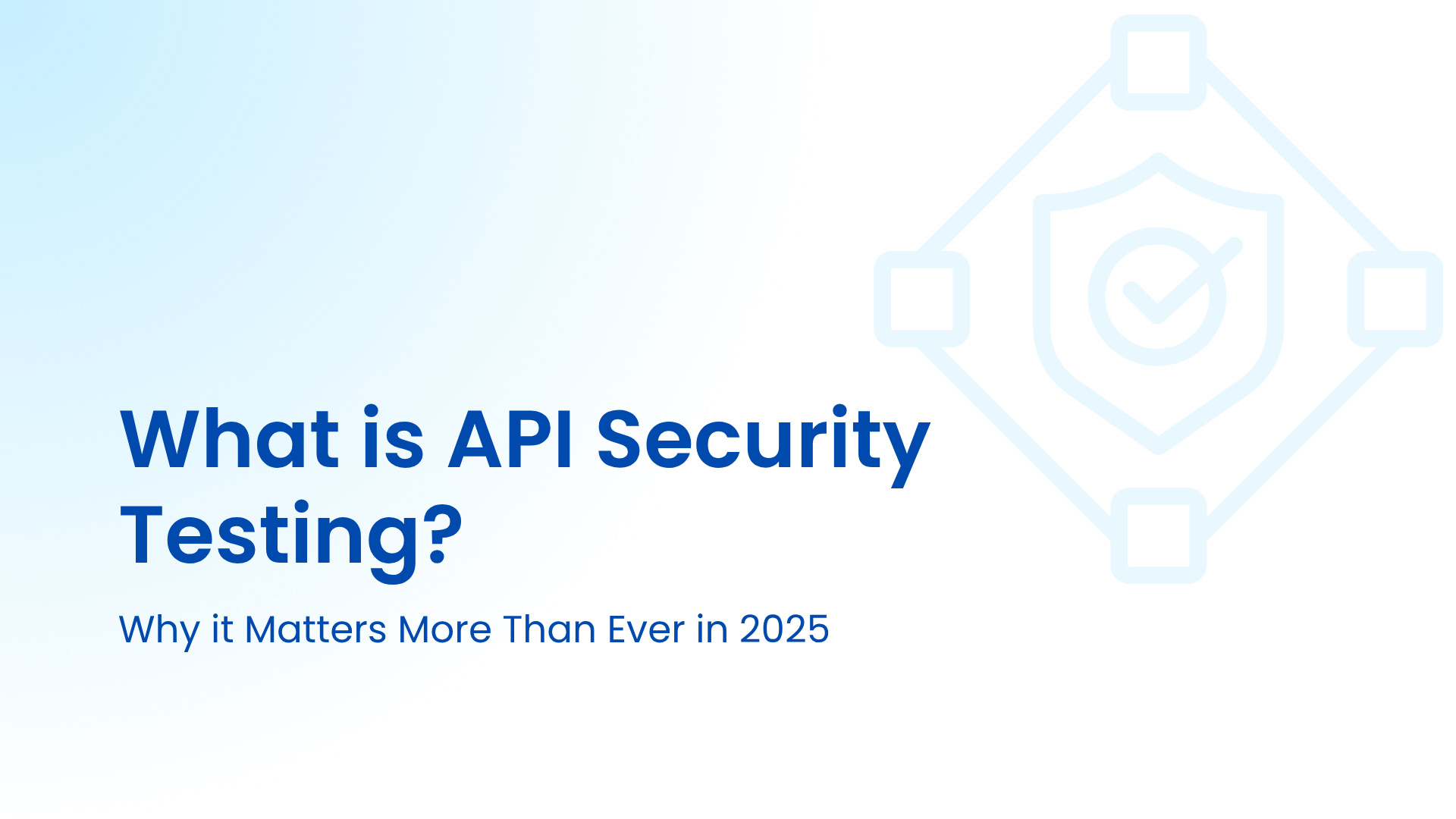APIs power digital businesses across sectors like mobile banking, healthcare systems, ecommerce, and AI-driven SaaS platforms, handling more than 90% of all web traffic. They connect microservices, enable data exchange, and make modern digital experiences possible.
But this connectivity introduces serious risk. Gartner predicts that by 2026, 80% of data breaches will involve insecure APIs, often due to untested or poorly protected endpoints. IBM’s 2025 Cost of a Data Breach Report found that API-related breaches, especially those involving compromised interfaces, carry significantly higher costs, one study noted that incidents spanning multiple environments averaged US $5.05 million, compared to the global average of US $4.44 million.
APIs are now both the engine and the entry point of digital business. Securing them isn’t optional, but foundational. That’s why API security testing has shifted from a compliance checkbox to a core discipline that protects data, customer trust, and business continuity.
What Is API Security Testing?
API security testing is the process of identifying and fixing vulnerabilities in APIs before attackers can exploit them. It ensures every endpoint is secure across authentication, authorization, data handling, and configuration, validating how APIs manage identity, process inputs, and protect sensitive information.
A robust testing strategy examines multiple layers of API behavior:
- Authentication: Verifies users and services are who they claim to be.
- Authorization: Ensures access is limited to only what’s permitted.
- Input Validation: Detects injection and manipulation attempts that could alter logic or expose data.
- Data Protection: Confirms encryption, tokenization, and secure data handling practices.
- Configuration: Checks that tokens, headers, and integrations are properly secured.
Modern API security testing tools go far beyond manual or one-off scans. Advanced tools now simulate real world attack scenarios to uncover business logic flaws, data leaks, and broken access controls long before production. These platforms integrate directly into the software development lifecycle (SDLC), bringing continuous testing into development, staging, and runtime environments.
By combining static (SAST), dynamic (DAST), and interactive (IAST) testing with fuzzing and behavioral monitoring, teams can detect vulnerabilities early, enforce security policies automatically, and maintain compliance as code evolves.
Unlike traditional web app testing, which focuses on user interfaces, API testing examines how systems communicate. Continuous API security testing keeps pace with rapid releases, helping teams secure APIs at scale without slowing down innovation or performance.
Why API Security Testing Matters
Building APIs isn’t the challenge anymore, securing them continuously is. In today’s fast moving development cycles, new endpoints appear with every sprint, old ones linger unmonitored, and third party integrations multiply across environments. Manual or periodic testing simply can’t keep pace with this scale and complexity.
As organizations modernize their stacks, APIs have effectively become the new security perimeter. Each exposed endpoint can serve as an entry point for attackers, and the stakes are rising. Gartner predicts that by 2026, API-related breaches will account for over 50% of all web application attacks, underscoring why structured API security testing is now essential, not optional.
Here’s why continuous API security testing matters more than ever:
- APIs Are the New Perimeter: In cloud native and microservice architectures, APIs replace traditional network boundaries, making every interface a potential target.
- Shadow APIs Are Growing Fast: Over 60% of API related breaches stem from unmanaged or undocumented APIs, which often operate without authentication or monitoring.
- Attackers Are Getting Smarter: Modern exploits target business logic, token misuse, and subtle data flow flaws that static or legacy web scanners simply can’t detect.
- Compliance Is Tightening: Regulations like SOC 2, HIPAA, PCI-DSS, and GDPR now expect continuous API-level validation, not annual audits.
API security testing tools bridge this gap by continuously validating authentication, authorization, and data handling across live and pre production environments. Unlike traditional pen tests, they simulate real world attack patterns to uncover vulnerabilities before they reach production, reducing the likelihood and cost of breaches, which now average over $4.5 million per incident.
Ultimately, API security testing shifts security from a reactive defense to a proactive assurance model. It enables teams to build, deploy, and scale APIs confidently, protecting not just systems, but also the trust that digital businesses depend on.
Core Components of API Security Testing
A strong API security testing strategy goes beyond one-time scans. It spans the full API lifecycle, from design and development to deployment and runtime, ensuring every endpoint is secure by design and resilient in production.
Here’s what a comprehensive approach should include:
1. Authentication and Authorization Testing
APIs are only as secure as their access controls. Testing should verify how users and systems prove their identity and whether they can access only what they’re allowed to. With Authentication and Authorization Testing validate implementations of OAuth 2.0 and JWT to ensure proper token management.
Check for expired, missing, or tampered tokens that could enable unauthorized access. Detect privilege escalation and IDOR (Insecure Direct Object Reference) vulnerabilities that expose sensitive data. Finally, enforce least-privilege access across all endpoints to prevent lateral movement and overexposure.
2. Input Validation and Data Sanitization
Every input from query parameters to headers is a potential attack vector if not handled properly. Strictly validate data types, formats, and lengths to ensure inputs match expected patterns. Test for injection vulnerabilities such as SQL, NoSQL, command, and LDAP attacks. Enforce schema validation using OpenAPI or Swagger specifications to catch inconsistencies early. Always sanitize unsafe characters and encodings to prevent attackers from injecting malicious payloads or manipulating logic.
3. Encryption and Data Protection
Encryption must be enforced both in transit and at rest to maintain data integrity. Use TLS 1.2 or higher and ensure SSL certificates are valid and up to date. Encrypt all sensitive fields, including personally identifiable information (PII), payment card data (PCI), and protected health information (PHI). Regularly scan for data leaks in logs, error messages, or API responses to prevent inadvertent exposure. Rotate encryption keys periodically and retire outdated ciphers to maintain cryptographic strength.
4. Error Handling and Rate Limiting
APIs must fail safely. Avoid exposing stack traces, debugging details, or internal system information in responses. Standardize error codes and messages so that they provide necessary context to developers but reveal nothing to attackers. Implement rate limiting and throttling policies to block brute-force and denial-of-service attempts. Regularly simulate replay and flood scenarios to verify that your APIs remain resilient under attack without disrupting legitimate users.
5. Configuration and Deployment Security
Many API breaches stem not from code flaws but from poor configurations. Continuously identify open, unused, or undocumented endpoints and deprecate them promptly. Review and validate CORS, CSRF, and caching policies to prevent cross origin data leaks or unauthorized requests. Remove outdated dependencies, unused routes, and insecure integrations. Most importantly, never expose credentials or secrets in logs or environment variables, use secure vaults and key management systems instead.
6. Business Logic and Workflow Testing
Attackers increasingly target the logic that governs how APIs function rather than their technical implementation. Test multi step workflows, such as authentication, transactions, and order processing, to detect manipulation or bypass attempts. Validate each logical step to ensure it follows expected sequences and conditions. Simulate abnormal user behavior and edge cases to uncover hidden logic flaws. Monitor session state and workflow integrity to confirm that actions cannot be replayed or hijacked.
A mature API security testing strategy is continuous, automated, and risk aware. It doesn’t just find vulnerabilities, it also ensures that your APIs remain secure, compliant, and trustworthy as your business scales.
How to Automate API Security Testing
Modern API ecosystems evolve faster than humans can test them. Manual reviews and static scans can’t keep up with agile releases, microservices, and constantly changing third party integrations. Automation isn’t just nice to have anymore, it’s the foundation of modern API security. It delivers consistency, speed, and scale in an area that’s traditionally been slow and fragmented. The goal isn’t to replace human expertise but to amplify it across the entire API lifecycle, from development through production.
Shift from One-Time Scans to Continuous Testing
Traditional scanners were built for older, slower release cycles. They run scheduled or manual scans that provide only a point in time view of risk. But APIs are living systems, new endpoints appear, payloads evolve, and permissions change daily. Real world security demands continuous validation that evolves with your code.
With automated testing, every commit, deployment, and configuration change triggers security checks automatically. Vulnerabilities are detected and fixed before they reach production, without waiting for quarterly reviews or external audits. This shift turns API security from a reactive process into a real time safeguard that operates seamlessly within DevOps pipelines.
Combine SAST, DAST, and Runtime Analysis
Automation works best when it blends multiple testing approaches to eliminate blind spots and ensure complete coverage.
- Static Application Security Testing (SAST): SAST inspects source code, configurations, and API specifications early in the development phase. It detects issues like weak authentication logic, missing encryption, or hardcoded secrets before deployment, catching vulnerabilities when they’re cheapest to fix.
- Dynamic Application Security Testing (DAST): DAST simulates real world attacks on live APIs to expose vulnerabilities that static testing can’t see. It identifies injection flaws, authentication bypasses, or misconfigured headers in runtime environments where APIs actually operate.
- Runtime Testing and Monitoring: Runtime analysis observes APIs in production to identify anomalies, data leaks, and logic abuse in real time. It detects evolving risks, such as unauthorized integrations, privilege escalation, or session hijacking, that traditional testing methods miss.
Together, these layers form a continuous feedback loop from code to production and back. This ensures that vulnerabilities are caught the moment they appear, not weeks or months later, aligning API security testing with true DevSecOps maturity.
Common Pitfalls in API Security Testing
Even mature security programs can miss critical API risks. The speed of modern development, distributed ownership, and fragmented tooling often create blind spots that attackers exploit long before detection. To build resilience, teams must look beyond checklists and address these recurring gaps headon.
1. Relying Solely on the OWASP Top 10
The OWASP Top 10 is a valuable reference, but it’s not a complete strategy. Many real world breaches stem from logic flaws, workflow abuse, and business logic errors that aren’t covered by static lists. Security testing must adapt to the unique context and behavior of each API.
2. Ignoring Internal or Shadow APIs
Untracked or undocumented APIs often bypass authentication, lack monitoring, and handle sensitive data without oversight. These “shadow” endpoints are among the most common sources of breaches because they fall outside standard visibility and testing frameworks.
3. Treating Testing as a One-Off Task
APIs evolve with every sprint. A security test done last quarter may already be outdated. Effective API testing must be continuous, automated, and embedded in CI/CD pipelines to detect vulnerabilities as soon as they appear.
4. Using Unrealistic Test Data
Testing with synthetic or sanitized data may overlook real world edge cases, such as malformed payloads or unusual access patterns, that attackers routinely exploit. Incorporating realistic test data ensures scenarios reflect true operational risk.
5. Fragmented Tooling
When teams use disconnected tools for code scanning, runtime monitoring, and compliance, critical insights fall through the cracks. Centralized observability across environments and toolchains is essential for accurate, actionable risk assessment.
Best Practices for Effective API Security Testing
API security isn’t just about finding vulnerabilities; it’s about maintaining trust as your systems evolve. With APIs changing daily, traditional one time testing falls short. A modern approach focuses on automation, continuous validation, and context-driven prioritization to keep pace with real world threats.
1. Shift Left Security
Test early during development, not after deployment. Integrating API security checks into the SDLC helps teams catch misconfigurations, broken access controls, and schema flaws before they reach production.
2. Automate the Essentials
Manual reviews can’t scale with agile pipelines. Automate schema validation, authentication testing, and vulnerability scans so that every commit and build gets tested without delay.
3. Retest Continuously
APIs evolve with every release. Continuous testing ensures that new endpoints, integrations, or configuration changes do not reintroduce old vulnerabilities or create new ones.
4. Prioritize by Data Sensitivity
Not all APIs carry the same risk. Focus testing and monitoring on endpoints that handle critical data such as personal, financial, or healthcare information to maximize security impact.
5. Centralize Results
Disparate tools create fragmented insights. Consolidate pre-deployment and runtime results into a single dashboard for unified visibility and faster triage.
6. Correlate with Live Behavior
Static test results tell only part of the story. Combine them with runtime behavior such as traffic patterns or failed authentications to prioritize real, exploitable risks instead of theoretical ones.
How Levo.ai Elevates API Security Testing
Modern security demands more than scanners. It demands intelligence. Levo.ai brings automation, visibility, and intelligence to every stage of the API lifecycle. It unifies discovery, validation, and runtime protection in one integrated system, helping teams secure APIs at the same speed they ship code.
1. AI-Driven Behavioral Detection
Levo uses adaptive machine learning to identify abnormal behavior, access control gaps, and data exposure risks that traditional vulnerability scans often miss. It learns from real API traffic to detect threats in context, not just by signature.
2. eBPF-Based Runtime Monitoring
Levo captures live API traffic directly at the kernel level using eBPF. This approach provides complete visibility without relying on agents or proxies and ensures that no customer data is ingested or exposed.
3. CI/CD Integration
Levo integrates seamlessly into CI/CD pipelines to run automated tests before and after deployment. This allows developers to detect and fix vulnerabilities early without slowing down delivery or breaking workflows.
4. Privacy-First Architecture
Built on a zero data model, Levo ensures full compliance with SOC 2, HIPAA, and GDPR by analyzing traffic and metadata locally without storing or transmitting sensitive information.
5. Risk Prioritization and Automated Remediation
Levo automatically ranks findings based on exploitability and data sensitivity, helping teams focus on the issues that matter most. It can even generate automated fixes for common misconfigurations to reduce response times.
With Levo.ai, API security testing becomes continuous, intelligent, and proactive, aligning seamlessly with the pace and demands of modern software delivery.
Achieve 100% API Security with Levo. Book your Demo today to implement API security seamlessly.
The Bottom Line
APIs now define how digital ecosystems communicate and also the primary entry point for attackers. Traditional security methods simply can’t keep pace with fast-changing, interconnected environments. API security testing is no longer a checkbox exercise; it’s the foundation of digital trust.
Effective testing ensures innovation doesn’t come at the cost of exposure, and that speed never compromises safety. Platforms like Levo.ai make this possible by automating API security from design to runtime, turning protection into a continuous process rather than a reactive one.
Levo.ai doesn’t just detect vulnerabilities; it actively safeguards APIs as they evolve. For organizations operating at scale, now is the time to modernize your testing strategy.
Shift left, automate early, and secure continuously. That’s how resilient API security and sustainable innovation are built.





.png)
.png)
%20(1).png)
